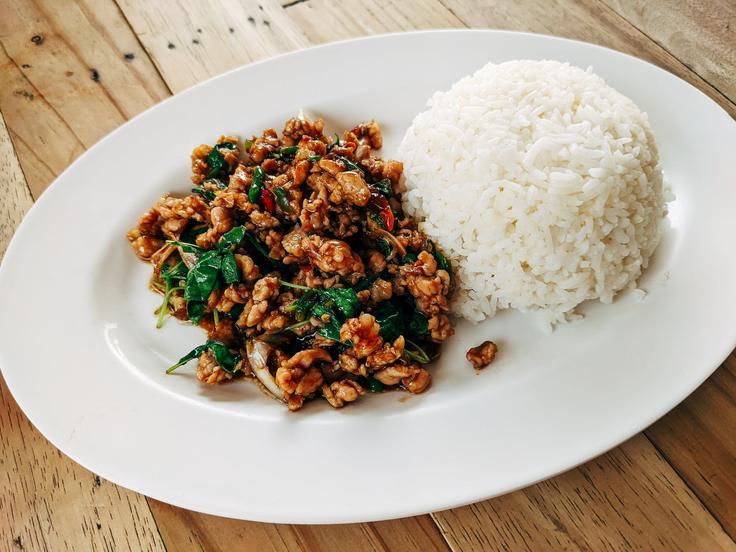Picture the most fascinating food tale! While Pad Thai is now a superstar of Thai cuisine worldwide, it actually didn't exist until the 1930s. Enter the scene: Prime Minister Plaek Phibunsongkhram, or the legendary Phibun. With a mission to promote Thai identity, Phibun decided to create a national dish that would unite the nation. Phibun's plan involved distributing a standardized pad Thai recipe to street vendors, and the rest is history in the making. This humble stir-fried noodle dish quickly gained popularity not only in Thailand but across the globe. It became an international sensation, representing Thai cuisine on a global scale.
But here's the intriguing twist: Pad Thai's story is part fusion, part government propaganda. While it has become synonymous with Thai food, its origins may have been influenced by external elements. The dish's fusion of flavors and techniques reflects the cultural exchange happening during that time. Therefore, what is Thailand's national dish?
Thailand's national dish is Pad Krapao, a delectable stir-fry of minced meat, Thai holy basil, garlic, chilies, and savory sauce served with rice.

Phibun's ingenious plan successfully put Thailand on the culinary map, but it raises the question of whether Pad Thai is purely Thai. Nonetheless, its mouthwatering combination of stir-fried noodles, tangy tamarind sauce, and a medley of delightful toppings has captured hearts and taste buds worldwide.
From the bustling streets of Bangkok to trendy restaurants in New York City, Pad Thai has become a beloved symbol of Thai cuisine. Its journey from government decree to global sensation is a testament to the power of food in shaping cultures and transcending borders.
So, the next time you savor a plate of Pad Thai, remember its fascinating history. It's not just a delicious dish but a reflection of the dynamic evolution of Thai culinary traditions. Whether you enjoy it with a side of curiosity or a dash of nostalgia, let the flavors transport you to the vibrant streets of Thailand and remind you of the culinary wonders that unfold when fusion meets tradition.
The origins of Pad Thai, originally known as "Gway Teow Pad Thai," trace back to the Chinese influence in Thailand. Some believe that a similar dish was brought to the Ayutthaya Kingdom by Chinese traders in the 1700s. The name itself provides hints to its roots, with "Gway Teow" meaning rice noodles in Chinese and "Pad" referring to fried. The introduction of Pad Thai as a national dish, however, occurred in the 1940s under the leadership of field marshal Plaek Pibulsongkram.
The Thai government's campaign aimed to protect the country's rice resources and promote unity among the people. By encouraging the consumption of noodles instead of rice, they sought to improve dietary variety and instill a sense of national identity. Pad Thai emerged as the chosen national dish, potentially through a national competition. The public was told that by eating Pad Thai, they were supporting their country's interests.

Pad Thai has since become a beloved dish, particularly for its simplicity and tantalizing flavors. It consists of rice noodles cooked with a harmonious blend of hot, sweet, sour, and salty tastes. While commonly enjoyed in Thai restaurants, Pad Thai can also be recreated at home with easily accessible pantry ingredients. The spiciness comes from chili sauce, sweetness from palm sugar, sourness from tamarind, and saltiness from fish sauce (or soy sauce for vegetarians).
Another popular Thai comfort food, Pad Kra Pao, has its origins in mid-1900s street food culture. It features minced pork or chicken stir-fried with garlic, shallots, and Thai bird's eye chilis. The aromatic and spicy stir-fry is then combined with a sauce made from soy sauce, oyster sauce, and fish sauce. Fresh holy basil leaves are added for fragrance and balance. Pad Kra Pao is commonly served with steamed jasmine rice and a fried egg.
Field marshal Plaek Pibulsongkram's efforts not only established Pad Thai as a symbol of patriotism but also promoted its affordability and accessibility. By encouraging widespread consumption and making it an affordable street food, the dish gained popularity, supporting rice exports and becoming a cherished national dish.
The influence of Plaek Pibulsongkram's campaign continues to be felt as Pad Thai and other Thai dishes remain beloved culinary treasures, celebrated for their rich flavors, cultural significance, and widespread appeal.
What is actually the National dish of Thailand?
When it comes to Thai cuisine, one might assume that the famous Pad Thai holds the coveted title of the national dish of Thailand. However, in a surprising twist, the true national dish is actually Pad Kaprao. This revelation might come as a delightful surprise to food enthusiasts and Thai cuisine aficionados.

Pad Kaprao, also known as Pad Kra Pao or Basil Stir-Fry, is a beloved and iconic Thai dish that has captured the hearts and palates of locals and visitors alike. Its popularity and cultural significance make it a strong contender for the coveted national dish title.
The origins of Pad Kaprao can be traced back to Thailand's street food culture in the mid-1900s. It emerged as a comforting and flavorsome stir-fry dish that quickly gained immense popularity among the Thai population. The dish is traditionally made by stir-frying minced pork or chicken with garlic, shallots, and Thai bird's eye chilis. These aromatic ingredients infuse the dish with their unique flavors, creating a fragrant and spicy delight.

The defining element of Pad Kaprao is the generous addition of holy basil leaves, which add an unmistakable herbal fragrance and a delightful touch of freshness. The combination of savory and spicy flavors, along with the aroma of basil, creates a harmonious balance that is characteristic of Thai cuisine.
So, why is Pad Kaprao considered the true national dish of Thailand? The answer lies in its cultural significance and widespread popularity among the Thai people. Pad Kaprao perfectly embodies the essence of Thai comfort food and is a staple in Thai households, street food stalls, and restaurants across the country. It represents the heart and soul of Thai culinary traditions and showcases the flavors that Thai people hold dear.
While Pad Thai enjoys global recognition and is often associated with Thai cuisine, Pad Kaprao holds a special place in the hearts of Thai locals. Its simplicity, bold flavors, and versatility make it a favorite go-to dish for many Thais, whether enjoyed for a quick lunch, a satisfying dinner, or even a late-night snack.
The rise of Pad Kaprao as the national dish of Thailand can be attributed to its deep-rooted cultural significance, its ability to bring people together, and its reflection of the diverse flavors found in Thai cuisine. This flavorful stir-fry represents the spirit of Thai culinary traditions and embodies the passion and pride that Thai people have for their food.
So, the next time you find yourself craving authentic Thai flavors or exploring the culinary wonders of Thailand, be sure to savor a plate of Pad Kaprao. Let the fragrant basil, spicy chilis, and savory stir-fried goodness transport you to the bustling streets of Thailand, where food is not just sustenance but an integral part of the vibrant culture and warm hospitality that the country is known for.
Final thoughts
In conclusion, the culinary world is a delightful tapestry of flavors, stories, and cultural exchange, and Pad Thai's journey epitomizes this rich tapestry. From its humble beginnings as a government-promoted dish to its global recognition as a Thai culinary ambassador, Pad Thai has left an indelible mark on the taste buds and imaginations of food enthusiasts worldwide.
The story of Pad Thai reminds us that food is not only nourishment but a powerful cultural connector. It represents the fusion of influences, the creativity of chefs, and the evolving tastes of a nation. It serves as a reminder that culinary traditions are ever-changing, adapting, and growing with the passage of time.
So, the next time you savor the complex blend of flavors in a plate of Pad Thai, take a moment to appreciate the journey that brought this dish to your table. Let it be a catalyst for exploration, curiosity, and celebration of the diverse culinary heritage that exists around the world.
Whether you're exploring the bustling street food scene of Thailand or recreating the flavors in your own kitchen, let Pad Thai be a delicious reminder of the beauty of cultural exchange and the power of food to bring people together.
As we continue to explore the world's cuisines, let us embrace the stories behind the dishes we love. Let us honor the traditions, creativity, and passion that go into creating each culinary masterpiece. And may our culinary adventures be filled with a sense of wonder, appreciation, and the joy of discovering new flavors.
In the end, Pad Thai is more than just a dish. It is a vibrant tale of history, culture, and the enduring love affair between people and food.

